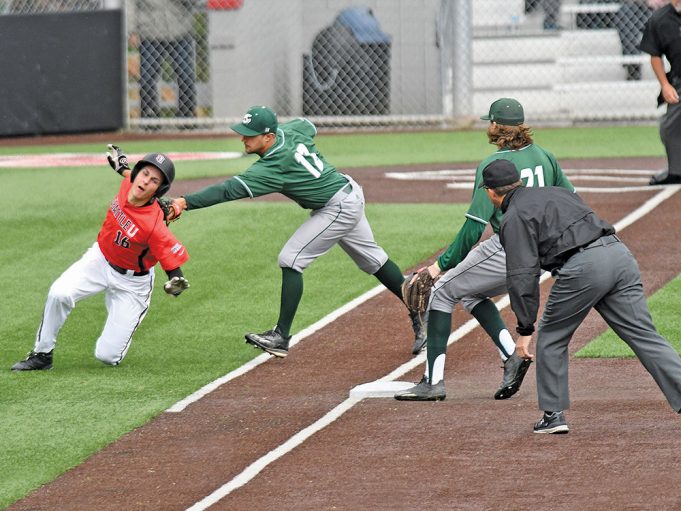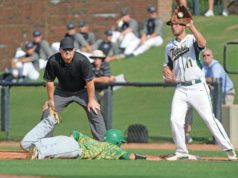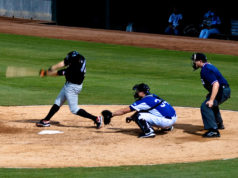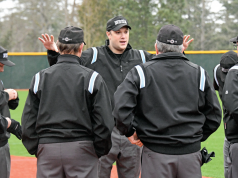What do you do when you’re struggling on the bases? We’re all going to have bang-bang plays where we do everything right but freeze-frame video shows we made the wrong call; that’s a function of being human. But what about the ones that we miss obviously, maybe even badly? What happened? And what can we do to recover?
Timing.
Good timing is as essential on the bases as it is on the plate. I have no idea why, but I always tended to be quicker in calling plays at first base and force-outs than I was on tag plays. I had to constantly engage in self-talk to make myself slow up in those situations.
So if you know you kicked a call, assess your timing; chances are that you called it too quickly. No matter how experienced we are or how sound our basic judgment is, our mind has to have a chance to process what our eyes have seen. Let the play go through to completion and then add a second or two before deciding. Fight the impulse to rush your call, especially if it’s a dramatic play like a runner trying to score the winning run with a perfect throw coming in. In these instances it’s easy to get caught up in the drama and think safe or out too quickly.
Positioning.
It’s more important to get a good angle on a play than it is to get on top of it. In the old days, for example, plate umpires from the big leagues on down called plays at the plate from up the third-base line. This resulted in them looking at the runner’s backside as he slid past into the catcher, and this horrible angle increased the chances of getting the play wrong.
In an NCAA regional tournament game, a veteran umpire ruled a player safe at the plate to give a team a victory and send it to the College World Series, although video showed the catcher tagged the runner a foot before he touched the plate. The umpire let himself get blocked out by being up the line, causing all hell to break loose.
In the early ’70s, when I was in the minors, NL umpire Frank Pulli created a stir when he began calling tag plays at the plate from his ball-strike position. This caught on as umpires realized they had a better view with the ball and runner coming into them. Now things have evolved so that umpires start on the third-base line extended and adjust depending on how the throw comes in and how the runner slides.
Trying to make the ball and runner come into you heightens your chances of being right at every base. We can’t always do this, especially in two- or three-umpire crews, but if I could, I did. As U2, I took steals of second from the shortstop side; as U3, I took plays with the throw coming from right field in foul territory, toward the home plate or the outfield side depending on how the play developed; and as U1 I took infield plays at first from just off the foul line in fair territory. This gave me a better chance to process what was happening and adjust to get a better view if necessary.
As for getting on top of the play, commentators and fans compliment this, but we can get so close that we lose sight of the forest for the trees. I tried to stay several feet away. As U1, for instance, I set up at least 15 feet back of the bag as I felt this improved my field of vision and made it easier to see things like a runner’s foot in relation to the base as the first baseman fielded a throw in the dirt.
You can’t see all the fine detail of the play if you’re on the run and your eyes are jiggling
Maybe you kicked the play because you weren’t stationary. You can’t see all the fine detail of a play if you’re on the run and your eyes are jiggling. Sometimes it’s hard to force yourself to stop when you’re far away from a play, as in a two-umpire crew where you have back-to-back plays at different bases, but you’re better off to do this and focus on getting the best angle.
Anticipation.
In the 1984 College World Series, I was working second base. A runner at first broke too quickly and my mind registered this as an easy out. The pitcher completed his pick to the first baseman who threw to second, but it was high so that the fielder had to climb the ladder. By the time he applied the tag it was on the runner’s upper arm with the rest of the arm over the bag. Because I had my mind made up before the play happened, I didn’t assess it objectively. My mistaken “out” call snuffed out a rally and likely cost that team the game.
We set ourselves up to fail if we anticipate how a play will develop, even subconsciously and for a split second. If Sam hits a ground ball in the hole so F6 has to backhand it, we can’t afford to let our first reaction be that there’s no way F6 can make the play. That plants a seed in our mind that’s hard to overcome if we suddenly have a whacker because Sam tripped coming out of the box or is just slow. Same thing if Bob hits a ground-ball bullet to F5 so that our mind instantly registers out but the runner is especially fast and beats the throw by an eyelash.
Making this mistake once caused me to ring up a guy at least a half-step past first when the throw got there. When the coach argued, I told him I got confused and thought the runner was coming from the opposite direction. He actually laughed.
In sum, if you think you missed a call, run through a checklist of these possible reasons. If you identify the problem, you’ll be less likely to screw up the next one. And then put it out of your mind, turn the page and move on, or the misses will continue to happen.
What's Your Call? Leave a Comment:
Note: This article is archival in nature. Rules, interpretations, mechanics, philosophies and other information may or may not be correct for the current year.
This article is the copyright of ©Referee Enterprises, Inc., and may not be republished in whole or in part online, in print or in any capacity without expressed written permission from Referee. The article is made available for educational use by individuals.


















